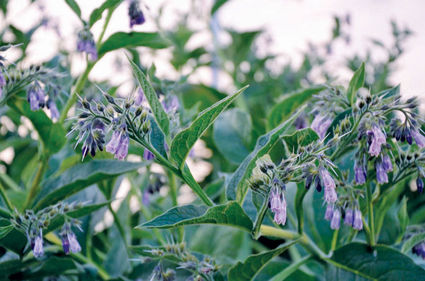Caution with comfrey!
Herb snips
July 21, 2018
Comfrey, (Symphytum officinalis) is an ancient perennial herb. The Romans called it conferva meaning, "join together." This refers to its ability to heal bone fractures and skin wounds. There are many species but you should stick with the S. officinalis because some others are very poisonous. Even this species has its health cautions which we will discuss.
Comfrey prefers a moist, rich soil and is deeply invasive. It will tolerate sun, but I find partial sun best in our summer heat and it cuts down on the watering. I grow it in a deep container because I can control all of these factors. It grows to about 2-feet with large fuzzy leaves and clusters of purple bell shaped flowers. Its rhizomatous roots are black and may be 10 times more potent than the leaves. It can be propagated by seed, by dividing roots in the fall and from cuttings at any time. Handling the plant can cause dermatitis in some people, so I suggest you use gloves.
Organic farmers use comfrey for mulches, compost and fertilizers. It has nitrogen and is used in compost piles as the activator because it heats things up. According to Pinetree Garden Seeds, it has all the essential nutrients for plant growth.
In the winter during dormancy the roots are harvested and dried for decoctions, liquid extracts and ointments. The young leaves are picked before flowering and dried for infusions, liquid extracts and poultices. According to the Herb Society of America and other sources, these are the times when the beneficial component allantoin is prevalent in the plant. This is the component that promotes cell proliferation and is now synthesized by drug companies for healing creams. You can find these products online.
Now the cautionary tale! Since 400 BC comfrey had been acclaimed as a healing herb for many ailments including problems with bones, skin, external sores and even internal upsets. The common name "knitbone" says it all when it comes to healing fractures. It is most useful today in the rib area where bandaging does not work.
In 1978 two research studies caused the controversy over the safety of comfrey. One demonstrated that rats that were fed 8 percent comfrey leaves developed liver cancer in six months. The other study showed that certain alkaloids in comfrey cause liver problems in rats. Proponents for comfrey like the Henry Doubleday Research Association claim that the amount of cancer causing alkaloid in the plant is so small that in moderation it is unlikely to cause problems.
In 2001 the FDA started restricting the use of comfrey in dietary supplements taken internally. Creams are still available. Use a reputable supplier and read the labels carefully if you decide to use comfrey. It is absorbed through the skin, so more is NOT better.
I prefer to err on the side of CAUTION and would not take it internally or apply it to open wounds. The intensity of the damaging alkaloids varies with harvesting time and it is difficult to determine how concentrated the solution is you are using. The roots can be 10 times as strong as the leaves. This makes home preparation as well as purchasing a real challenge.
A big thanks to Jo Walker for suggesting this column topic and her friend on the Tehachapi Gardener's Facebook page for her interest is this herb of antiquity. I hope this column is helpful to you all. No cautions when it comes to herb questions or suggestions! Please keep them coming to: http://www.herbbasket.net or eamherb@sbcglobal.net.





